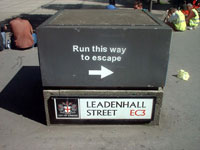|
|
|||||||||||||||||||||
ANARCHITECTURE
Space Hijackers
As the world ascends towards a state of global capitalism, corporations and institutions are playing an increasing role in our lives. The competition of the market is forcing companies to develop highly specific methods of research to trace trends within populations and monitor the habits of individuals. Information is now stored about every minute detail of our lives - to aid business and government in predicting our reactions and to plan as a preemptive strike.Data collection agencies exist in order to predict things ranging from what you are likely to spend your wages on to which direction you are most likely to turn when entering a shop (right, in case you were wondering). The creation of the "correct" environment for work or retail space, can greatly affect the productivity of that space, and is becoming a matter of ever more anxious and particular attention. In our current climate business can't afford to get these things wrong. You can no longer innocently go about your business, people will want to be prepared for every move you are likely to make.
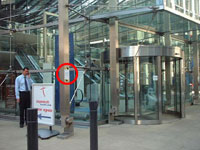 |
Every space that you pass through will have been designed with you in mind. The utilisation and design of architecture is playing an increasingly important role in the corporate world. Governments and corporations have infiltrated all corners of urban space. Every street is now brimming with security cameras (for our protection of course), every public space is designed with traffic flow in mind. People have become units to be directed and physically moved around space. The State creates a system within which we move and live, a functional space on a massive scale. Control over the users of space often takes the form of obvious physical devices within architecture, however contemporary architecture also uses much more subtle devices within its design. It now works on a psychological as well as physical level. Space is designed to affect our moods, and put us into the frame of mind that companies require in order to be in a position to compete with their rivals. This requires that they use both the language of their architecture and the knowledge of how we will react to space. |
Retail
Retail establishments are designed with specific devices, which have been developed after hours of painstaking observation of our reaction on security tapes, and monitoring sales figures in comparison to shop layouts. Competition between such establishments is rife, and in order to compete companies are resorting to clandestine methods. Companies are contracted to research consumer habits, and pass on this information to shop designers who will put it to use. The ends of supermarket aisles are now rounded so that your eyes need never be averted from the stock, different sized tiles are placed on the floor with smaller ones in more expensive areas, causing your trolley to click faster and you to slow down. Department store executives know that most people turn right after walking through the door, so this is where you will often find the best bargains, or lines they have an interest in selling. They also carpet sections of their stores and leave others with vinyl passages, in order to control your movement around the shopping floor. Architecture is analogous to a type of language. Buildings and the layouts and components within them can act as a text, instructing users how they are intended to be used and affecting the ambience of the space. Users of space read this language in a distracted manner, the messages and signifiers are therefore not consciously noted. We are too busy with whatever business we are there for to take time to decipher the language of the space, and through our distraction our experience of space is controlled.
Corporate Space
It is through a process of mythification that corporate space claims a dominance over the users and visitors of space. This is an essential part of contemporary business, where corporate image and reputation can make or break a company on the stock market. Confidence is valuable currency in business. Corporate architecture acts as a signifier of the myth of the efficient and powerful corporation, it is the physical symbol and public face of that corporation. Its forms demand that the myth be read as such, although as with all signs the link is arbitrary. A vocabulary of signs is built up and reused by corporate architects in order to exert control over the mood and behaviour of the users of that space. The people who work in the city believe the myths of the city and try to live up to the image of the efficient, business-like lifestyle. Of course they don't manage it, nobody does, from office clerks to managing directors, so dissatisfaction sets in. People work harder in order to keep up their appearance, and corporations benefit.
Architects
Users of space are placed in a position of subordination to the owners of space. This hierarchy is hardly unexpected. Space is designed by its owners to exert control over its users - and the services of architects are employed for this means.
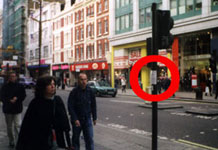 |
Architects work by commission, they are presented with a set of requirements and design a space to meet them. They have to drop any moral obligation to the users of space when accepting the commission, and it is not so difficult, as architects have a very different relationship with space than other users. Architects work with a pure architectural space that can be contemplated much like a work of art. General users of space see it as a mere background to our experience of the world. We take notice of architecture in a distracted way by not noticing; it is somewhere on the periphery of our vision. An architect does not react to space in the way that a shopper would, as the two approach space looking for different things. After years of formal training to recognize the "subtleties" of space, an architect can never look at it again with innocent eyes. |
The users of space are a disturbing element that enter into the field of architecture, they are something random that the architect cannot design. To compensate for this unpredictability, space is designed to control and manipulate its users into harmony with their surroundings. In order for this space to function as it is meant to, users must be guided around it by various architectural methods. Because people disrupt the harmony of built space, they are not something the architect relishes, and so do not form part of his or her vision. We simply need to look at architectural photography to see this in evidence. Architectural photographs are shot with one specific requirement - that the space is clear of people. Through representing space in photography and design, the architect can withdraw it from reality, and therefore escape any moral obligation to the intended users of that space. It is a chilling thought to think that it is precisely through such strategies that architects win multimillion-pound commissions. It is by looking at humanless drawings and lifeless plans that commissioning agents decide on how they would like their spaces to look. Governments and corporations pick our landscape, the stage that affects everything that we do, from designs which by their very nature attempt to withdraw all human life and present an empty, "pure" space.
Language
The language that architects and corporations employ is a very fragile thing. Architecture is like a written language, and just like the letters on this page, it requires a certain knowledge in order to be understood. As with any language system, the link between signifier and signified is an arbitrary one. It is only by social convention that we read language as we do, this applies to architecture as much as it does to the English language. Language is a construct of the society that uses it, it is a system of signs that are developed and used by that society in order to have a common understanding. Language only exists within the group of people that use it, it is not a physical but rather an abstract thing. Language is also something that can change over time. The potential flexibility of architectural language offers a weakness in the grip that architects and corporations have over the users of space. It is by corrupting the language and signification of architecture (by producing events, objects, and their language) that a real form of resistance to architecture can be found. Myths can be demystified and signs rewritten.
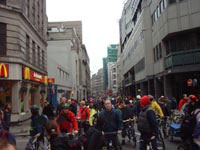 |
Space Hijackers are Anarchitects who oppose the hierarchy that is imposed upon us by architects, planners and the owners of space. We operate in London, a city in a State of advanced capitalism. We are based a stone's throw from the Square Mile, one of the most concentrated spaces of capitalist architecture within Europe, if not the world. Here we work to combat the oppressive effect that such space has over the people that live and work here. The Space Hijackers' objective is to effect and change the physical space of architecture - the very point where advanced capitalism comes into contact with the general public. During anti-globalization protests, when a Mc Donald's shop window is broken, it can be easily replaced days afterwards - the way the company works is not destroyed simply because the windows are smashed. The Space Hijackers are not about anti-brand protest, rather our methods aim to invade and re-brand corporate space. |
We attempt to create situations or place objects within architectural space that affect the way in which that space is experienced. This is possible by creating myths within space that will then go on to become a part of that space. The authority of the owner's text is unbalanced as other voices make themselves heard. The actions and objects we create become a part of the history of the space and thus become part of its language. The aim is to produce an oral architecture, which critiques thearchitectural space and re-contextualises it. The oral language exists within the minds, habits and beliefs of the community that use the space. It is through a type of contagion that spreads by word of mouth that the intrusion into architectural space can become part of the oral history of that space. Singular authoritarian texts vanish under a confusion of other conversations.
Corruption
Events change not only the history of the space, but also project a future. By setting up alternative realities and uses for space, we can spread confusion into the meaning and language of that space, reducing the authority of the people who own it.
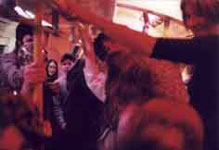 |
On 10th March 1999, we hijacked a London Underground Circle Line Train, for the purpose of turning it into a moving disco. A vast amount of preparation took place beforehand - we had to build suitcases that would transform instantly into a bar, stereo, nibbles counter or disco light. Around 150 people attended the event, not including the passengers who happened to get on the train. All passengers were given free Vodka, Tequila, and Sweets. The London Underground remained blisfully unaware of what was happening right under their noses. The point of the event was to disrupt the way in which the train system enforces codes of conduct by destroying any previous ideas about how to behave on a train, and what a train is used for. We wanted to corrupt passengers' future experience and expectations of the Circle Line, as the memory of the party will recurr each time they use the train.The possibility of having a party on the train has now been made concrete, and so this has already become part of the language of the space. |
Our work attempts to confuse the existing language of architecture, not to replace it. It is not a matter of one system of ideas replacing another, but rather of a process of corruption. We are not attempting to produce a new revolutionary order that can replace the old - as this is destined to fail. Global capitalism, and the architectural systems that it has produced as its safeguard, is a power that grows stronger still by using the very people who try to oppose it. If we aim to change the ways of the world, we can't play by the same rules, as we will lose by being trapped back in the same system. But these rules - of the system of architecture that commands us - are all formed through language. This language is something that exists solely within the minds of the people who use it. If we change the language, we can start to change the game. We mess with the system as opposed to simply feeding it. By affecting architecture in this way, it offers users of space a way around the control of the owners and designers of space. Owners have no control over the oral nature of architectural language. A company can only own the written text of a building, the fabric and materials that make it up. But the author of this text is effectively dead, and the text can be read in many different ways. Architectural language is a product of the the people who use it, and is not inherent in the architecture itself.
Control for corporate gain is allowed, passively, by the very people who are controlled. We are as responsible for the state of language, as the owners who use it to extract a profit. The users of space constitute the greatest and most powerful force within the world of architecture - everyone is a user of space. Consequently, everyone is a potential creator of that space. We simply need to change the language, from one that uses us, to one that we can control. By creating new and contrasting myths and stories within architectural space, we can create 'Anarchitecture', an alternative use of the architecture in which there is no hierarchy of control. The architectural language of places can be corrupted by merely spreading different ideas about the use of these spaces within the communities of users. This requires a method of splitting apart architectural myths and creating a space that is open to new forms of appropriation. A method of concrete change here and now as opposed to counting time waiting for yet another utopian revolutionary ideal.
